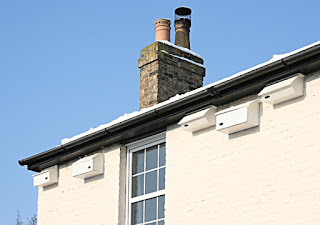This project demonstrates a technique that has been used several times in the UK, but using commercial, off-the shelf products. Though possibly more expensive, the end result looks very professional. It uses identical products to this project. Whereas in this country, most projects have attempted to make the entrances 'invisible' (e.g. these four projects: 1, 2, 3 and 4), this project has some similarity to the very successful project in Fulbourn Cambs where the entrances were made conspicuous (5).
A heartening feature is the enthusiastic collaboration of the various stakeholders - municipal officers, local councillors, building contractors and other interested parties. Without this kind of cooperative effort, schemes of this kind are very hard to bring to fruition. Well done, the town of Jette.
We thank Martine Wauters for allowing us to translate and reblog the post on her blog. In her own words:
This is the realisation of a wonderful project: nest accommodation integrated into a school building
I am pleased to announce that a project that I have been dreaming about for the last 5 years has finally materialised: the installation of eight nestboxes for Swifts integrated aesthetically into the facade of a local school (French section and Dutch section) of my town in Jette (Brussels NW), as part of a renovation project.
And it is the kind of project that I like: the result of a successful collaboration with several groups and individuals: from the municipality, including two aldermen from different political parties and two officials from different departments); one building contractor and his team; and several national and international experts. My thanks to them all!
In alphabetical order, the contributors to this project are:
Louis Philippe Arnhem (Leuven), Swift expert
Laurence Bottini (Municipality of Jette), Municipal Heritage Department, and responsible for the building site.
Christel Matthijs, Director Gemeentelijke Basisschool Vande Borne (Dutch section of the school complex)
Edward Mayer (Swift Conservation, UK), Swift expert (www.swift-conservation.org)
Coralie Meeus (Municipality of Jette), Ecoconsultant
Dick Newell (Action for Swifts, UK), Swift expert (http://actionforswifts.blogspot.co.uk)
Johnny Van Belle (Euronet company), Entrepreneur, and his team (www.euronetvanbelle.be)
Sylvie Vanderhaegen, Director of the Jacques Brel School (French section)
Claire Vandevivere (Municipality of Jette), Environment
Bernard Van Nuffel (Municipality of Jette), Municipal Property Assets
They are pioneers in the Brussels region, and indeed in the whole of Francophone Belgium Let us hope their example will be followed by many other entrepreneurs, councillors, officials and individuals.
Abroad, experience has shown that this type of development is appreciated by Swifts, who prefer nest boxes affixed under ledges. Fingers crossed that Swifts will soon discover the five-star hotel we have created for them.
#inserts
A heartening feature is the enthusiastic collaboration of the various stakeholders - municipal officers, local councillors, building contractors and other interested parties. Without this kind of cooperative effort, schemes of this kind are very hard to bring to fruition. Well done, the town of Jette.
We thank Martine Wauters for allowing us to translate and reblog the post on her blog. In her own words:
 |
| The school before work started |
I am pleased to announce that a project that I have been dreaming about for the last 5 years has finally materialised: the installation of eight nestboxes for Swifts integrated aesthetically into the facade of a local school (French section and Dutch section) of my town in Jette (Brussels NW), as part of a renovation project.
And it is the kind of project that I like: the result of a successful collaboration with several groups and individuals: from the municipality, including two aldermen from different political parties and two officials from different departments); one building contractor and his team; and several national and international experts. My thanks to them all!
 |
| Components: a face-plate, a pipe and a nest box |
Louis Philippe Arnhem (Leuven), Swift expert
Laurence Bottini (Municipality of Jette), Municipal Heritage Department, and responsible for the building site.
Christel Matthijs, Director Gemeentelijke Basisschool Vande Borne (Dutch section of the school complex)
Edward Mayer (Swift Conservation, UK), Swift expert (www.swift-conservation.org)
Coralie Meeus (Municipality of Jette), Ecoconsultant
 |
| A view from the outside |
Johnny Van Belle (Euronet company), Entrepreneur, and his team (www.euronetvanbelle.be)
Sylvie Vanderhaegen, Director of the Jacques Brel School (French section)
Claire Vandevivere (Municipality of Jette), Environment
Bernard Van Nuffel (Municipality of Jette), Municipal Property Assets
They are pioneers in the Brussels region, and indeed in the whole of Francophone Belgium Let us hope their example will be followed by many other entrepreneurs, councillors, officials and individuals.
Abroad, experience has shown that this type of development is appreciated by Swifts, who prefer nest boxes affixed under ledges. Fingers crossed that Swifts will soon discover the five-star hotel we have created for them.
 |
| A view from the inside |
 |
| Inside view of 4 nest boxes |
 |
| Outside view of 8 entrances |
#inserts




















